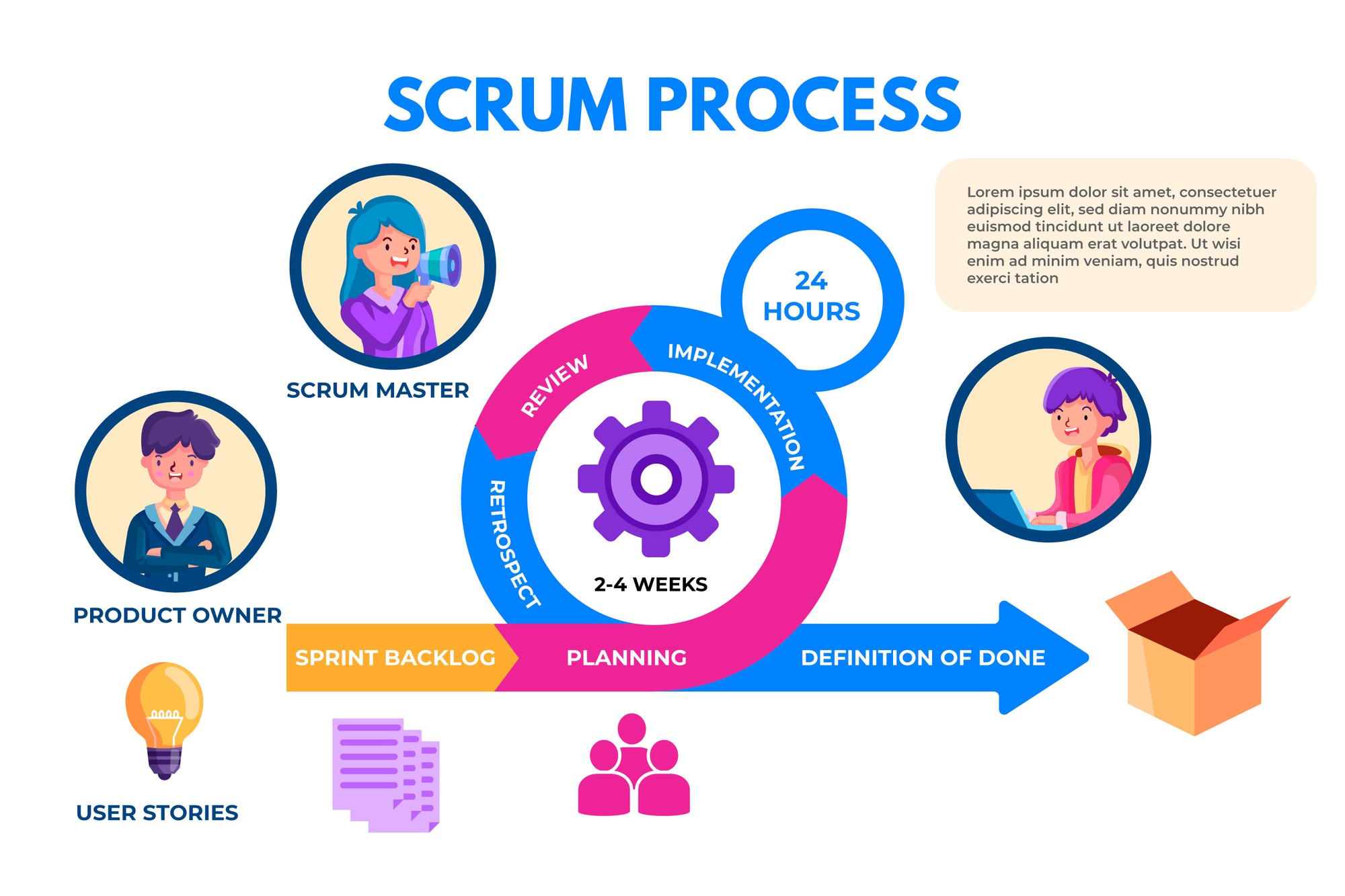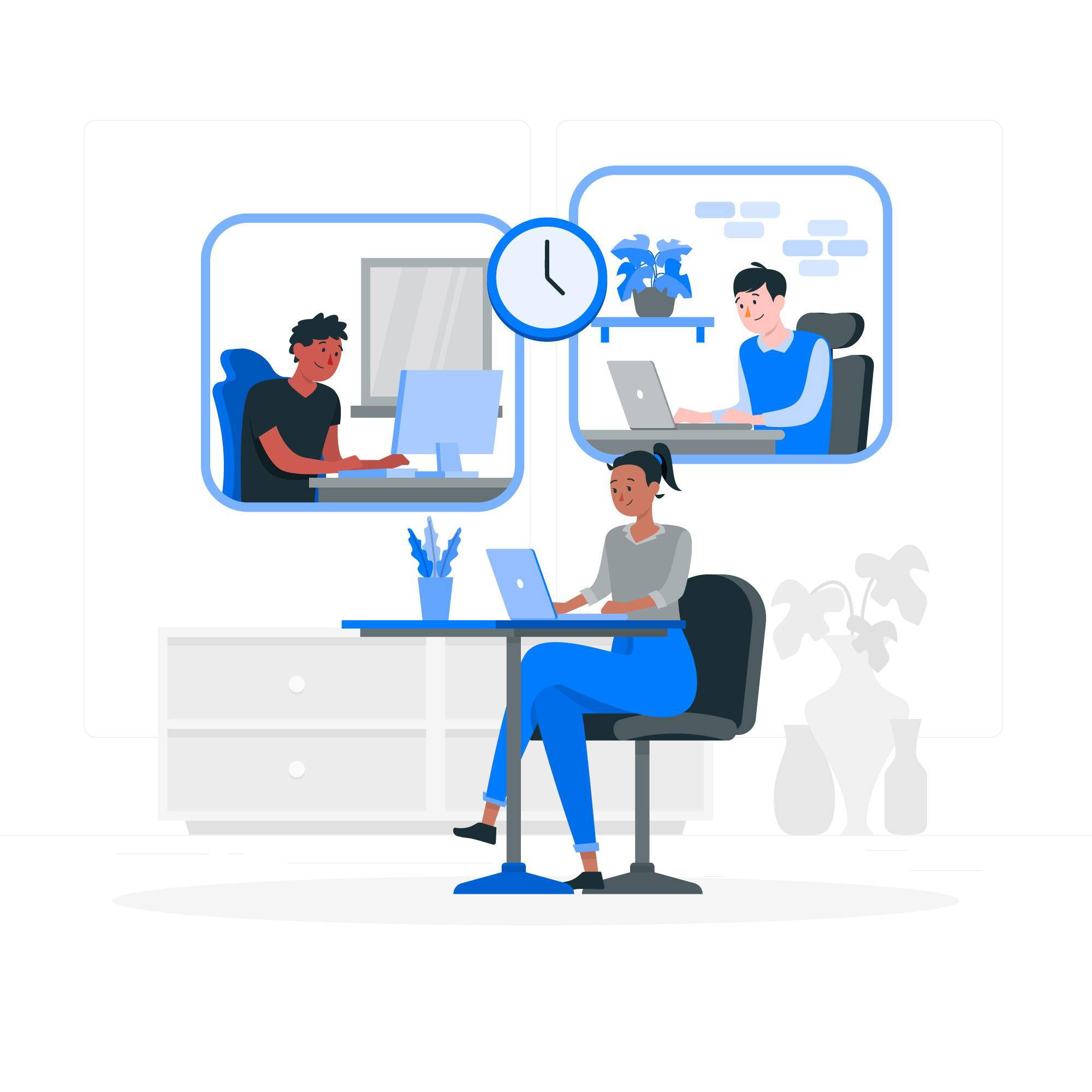In today’s ever-evolving professional landscape, the concept of remote work has transcended from being a mere trend to becoming the new norm.
As organizations embrace this shift, agile methodologies have emerged as crucial strategies for effectively managing teams, projects, and tasks.
One particular facet of this paradigm, product ownership within agile frameworks, has taken center stage in ensuring the seamless functioning of remote teams.
In this article, we’ll delve into the world of product ownership in agile environments in a remote work environment, exploring its significance, challenges, and strategies for success.

Understanding Product Ownership within Agile Frameworks
At its core, product ownership within agile frameworks involves a designated individual, the Product Owner or Product Leader, who serves as the bridge between the development team and stakeholders.
This role embodies the spirit of agility by being responsive to changing requirements and driving the project toward success.
Role of a Product Owner in Agile Development
In agile development, the role of a product leader is pivotal in ensuring the successful delivery of a high-quality product that meets the needs of customers and stakeholders. The product leader serves as the voice of the customer, bridging the gap between the development team and the external world.
Their responsibilities encompass a wide range of tasks that revolve around defining, prioritizing, and guiding the development of the product.
Here’s a comprehensive overview of the role and responsibilities of a product leader in agile development:
Visionary: The product leader sets the overall vision and strategic direction for the product. They have a deep understanding of the customer’s needs, business goals, and market trends.
Decision-Maker: The product leader is empowered to make decisions regarding the product’s features, functionality, and priorities. They determine what gets built when it gets built, and in what order.
Proxy for Stakeholders: Acting as the voice of customers, users, and other stakeholders, the product leader ensures that their requirements and feedback are accurately represented in the development process.
Prioritizer: The product leader prioritizes the backlog of work items based on value, risk, and other relevant factors. They make informed choices about what features should be included in each development iteration.
Collaborator: The product leader collaborates closely with the dev team, engaging in ongoing discussions, providing clarifications, and addressing questions to ensure a shared understanding of the product’s goals.
Effective Communicator: Clear and timely communication is crucial. The product leader conveys requirements, goals, and changes effectively to the dev team and other stakeholders.
Responsibilities of a Product Owner
The responsibilities of a product leader are multifaceted and encompass various aspects of product development:
Defining User Stories: The product leader creates user stories or other relevant artifacts that outline specific features, functionalities, and user requirements.
Prioritizing the Backlog: The product leader continuously refines and prioritizes the product backlog, ensuring that the most valuable and high-priority items are addressed first.
Making Trade-offs: In the face of constraints such as time, budget, and resources, the product leader makes tough decisions and trade-offs to optimize the product’s value and alignment with business goals.
Acceptance Criteria: The product leader defines clear acceptance criteria for user stories to ensure that the dev team understands when a feature is considered complete and meets expectations.
Reviewing and Accepting Work: The product leader reviews completed work during sprint reviews and has the authority to accept or reject the delivered features based on the predefined criteria.
Providing Clarity: The product leader is readily available to provide the dev team with clarifications and additional information as needed throughout the development process.
Adapting to Change: As the market and stakeholders’ needs evolve, the product leaderProduct Owner embraces change and adjusts the product backlog and priorities accordingly.
Engaging with Stakeholders: The product leader maintains open lines of communication with stakeholders, seeking feedback, and incorporating insights to ensure the product’s alignment with their expectations.
Continuous Learning: Staying informed about industry trends, customer preferences, and emerging technologies is essential for the product leader to make informed decisions.
Measuring Success: The product leader defines metrics and key performance indicators (KPIs) to measure the success and impact of the product, enabling data-driven decision-making.
In essence, the product leader is a pivotal figure who shapes the product’s direction, aligns it with business objectives, and ensures that the development efforts are focused on delivering maximum value to customers and stakeholders. Their ability to balance diverse perspectives, make informed decisions, and facilitate effective communication contributes significantly to the success of agile development projects.
The Role of the Remote Product Owner
In the intricate web of product ownership in agile environments within a remote work setting, the role of the Product Owner becomes both a guiding compass and a vital nexus of collaboration.
With geographical distances bridged by technology, the Remote Product Owner shoulders distinctive responsibilities navigates complex dynamics, and serves as a linchpin for seamless operations.
Responsibilities of a Remote Product Owner
The Remote Product Owner carries a multifaceted array of responsibilities that extend beyond geographical boundaries:
Visionary Leadership: Defining the product vision and aligning it with the overarching business goals, even from afar, provides a clear direction for the team.
Effective Backlog Management: Prioritizing user stories, refining the backlog, and ensuring that items are well-defined and aligned with stakeholder needs remain at the forefront.
Continuous Communication: Establishing and maintaining open channels of communication ensures that the dev remains informed, questions are addressed promptly, and a shared understanding prevails.
Collaboration with Distributed Scrum Teams
In the realm of remote agile, collaboration knows no boundaries. The Remote Product Owner orchestrates a symphony of collaboration, conducting interactions that traverse time zones and technological landscapes:
Virtual Meeting: Engaging in a virtual sprint planning meeting, backlog refinement, and review sessions ensures that the distributed scrum team remains in sync, united by a common purpose.
Cross-functional Engagement: Collaborating with developers, testers, designers, and stakeholders across locations amalgamates diverse perspectives into a cohesive whole.

Facilitating Real-time Feedback and Dynamic Interaction
While distance may separate team members, the Remote product leader bridges the gap through immediate feedback and dynamic interactions:
Timely Clarifications: Swift responses to queries and clarifications help the development team progress without hindrance, preventing bottlenecks.
Adaptable Decision-Making: Immediate feedback and guidance enable the team to make informed decisions, adjust priorities, and pivot as needed.
Fostering Innovation: Creating an environment where dynamic interactions flourish nurtures innovation, as ideas are exchanged and refined, regardless of physical location.
In the symphony of remote agile, the remote product leader is the conductor, orchestrating harmony through effective leadership, unwavering collaboration, and the power of real-time connections. Their role transcends distance, proving that while teams may be remote, the outcomes they achieve are nothing short of united success.
Agile Methodologies and Remote Teams
In the ever-evolving landscape of modern work, agile methodologies have emerged as guiding stars for efficient project management and team collaboration. Whether it’s Scrum, Kanban, or other variations, these methodologies offer a structured approach to product development while accommodating flexibility and adaptability.
In the context of remote teams, the synergy between agile methodologies and virtual work environments becomes a critical factor in achieving successful outcomes.
Agile methodologies are frameworks that emphasize iterative and incremental development. They promote close collaboration between cross-functional teams and stakeholders, fostering transparency, adaptability, and rapid delivery of valuable software.
Two prominent agile methodologies, Scrum and Kanban, showcase distinct characteristics:
Scrum Framework: Scrum is a popular agile software development framework. It operates in time-bound iterations called sprints. It consists of predefined roles (Product Owner, Scrum Master, and Development Team), scrum ceremonies (sprint planning, daily scrum meetings, sprint review, and retrospectives), and artifacts (product backlog, sprint backlog). Scrum’s structured approach promotes teamwork, accountability, and continuous improvement.

Kanban: Kanban focuses on visualizing work and optimizing flow. Work items move through a visual board with columns representing different stages of the workflow. It provides a real-time view of work in progress, enabling teams to manage their capacity, identify bottlenecks, and maintain a steady pace of delivery.
Challenges Posed by Remote Work for Agile Teams
While agile methodologies are well-suited for fostering collaboration and responding to change, remote work introduces unique challenges:
Communication Barriers: Lack of face-to-face conversation can lead to misinterpretation, reduced transparency, and slower decision-making.
Time Zone Differences: Coordinating activities across different time zones can hinder real-time collaboration and create delays.
Isolation and Engagement: The remote team member may experience feelings of isolation and reduced engagement due to virtual meetings compared to in-person meetings and environments.
Adapting Agile Principles for Remote Teams
To harness the benefits of agile methodologies in remote settings, teams can adopt several strategies:
Clear Communication Channels: Leverage digital communication tools for regular updates, virtual stand-ups, and open discussions to bridge communication gaps.
Virtual Collaboration Tools: Utilize collaboration platforms to visualize workflows, manage tasks, and facilitate real-time interaction among remote team members.
Synchronous and Asynchronous Work: Balance synchronous (real-time) collaboration with asynchronous (flexible time) communication to accommodate different time zones.
Transparent Documentation: Maintain up-to-date documentation, user stories, and acceptance criteria to ensure a shared understanding of project goals.
Frequent Feedback Loops: Schedule regular video conferences, reviews, and retrospectives to maintain a sense of team cohesion and continuous improvement.
In a remote work environment, agile methodologies retain their potency by fostering adaptability, regular communication, and iterative progress.
By recognizing and addressing the challenges unique to remote teams, agile principles can be seamlessly adapted, empowering remote teams to navigate complexities and deliver exceptional results.
Importance of Communication in Remote Agile Teams
In the context of the agile team’s remote working, communication emerges as the cornerstone of success
The physical separation inherent in remote work intensifies the need for effective communication. Clear and consistent communication ensures that team members remain aligned, priorities are understood, and potential roadblocks are swiftly addressed.
Without the luxury of face-to-face interactions, virtual communication channels become the lifelines that bridge the gap. Regular video conferencing, instant messaging, and collaborative tools facilitate real-time exchanges, minimizing misunderstandings and fostering a sense of connection.
Additionally, robust communication empowers the product leader to convey project goals, clarify requirements, and provide timely feedback.
In the absence of in-person cues, well-crafted communication becomes the adhesive that binds remote agile teams together, enabling them to navigate challenges and deliver impactful results.
Ensuring Collaboration and Self-Organization
In the realm of product ownership in agile environments within a remote work environment, two essential pillars stand tall: collaboration and self-organization.
These intertwined aspects form the cornerstone of effective teamwork, enabling remote teams to navigate complexities and drive projects to success.
Distance might separate remote team members physically, but the digital landscape offers a plethora of tools and strategies to bridge the gap. Fostering collaboration among dispersed team members is not only achievable but also crucial for project cohesion.
An agile methodology thrives on collaboration, and remote teams can leverage a variety of approaches to cultivate this synergy:
Virtual Brainstorming: Remote collaboration platforms allow team members to engage in brainstorming sessions, idea generation, and problem-solving discussions, just as they would in a physical meeting room.
Open Communication Channels: Utilize instant messaging, video conferencing, and dedicated chat channels to create an environment where team members can freely communicate, share updates, and seek clarifications.
Shared Documentation: Cloud-based document sharing and editing tools enable real-time collaboration on project documentation, user stories, and other critical artifacts.
By nurturing a culture of open communication and knowledge sharing, remote teams can harness the collective intelligence of their members, ensuring that every idea contributes to the project’s success.
Promoting Self-Organization Among Team Members
Agile standards emphasize the autonomy and accountability of the team member. In a remote setting, self-organization takes on heightened importance, as it empowers individuals to take ownership of their tasks, make informed decisions, and adapt to evolving circumstances.
Here’s how remote teams can encourage self-organization:
Clear Goals and Objectives: The product leader sets clear goals and communicates the overarching vision, allowing team members to align their efforts and self-organize around achieving those objectives.
Empowerment and Trust: Remote team members should feel trusted to make decisions within their areas of expertise. Empowering individuals fosters a sense of ownership and responsibility.
Adaptive Planning: Remote teams often need to adapt quickly to changing circumstances. By allowing team members to collaboratively adjust plans and priorities, self-organization thrives.
Regular Feedback: The product leader provides constructive feedback and guidance, empowering team members to reflect on their work and continuously improve their approach.
A well-fostered environment of collaboration and self-organization not only enhances the efficiency of remote teams but also promotes a sense of ownership and pride in the work being accomplished.
In the landscape of remote work, where physical presence might be absent, the strength of collaboration and the power of self-organization becomes the invisible threads that bind team members together.
Through intentional efforts to foster these qualities, product ownership within agile frameworks in a remote work environment can flourish, yielding remarkable outcomes and cementing the notion that geographical distance is no match for a cohesive and empowered team.

Overcoming Challenges and Pitfalls
Navigating the landscape of agile teams working remotely comes with its set of challenges and potential pitfalls. However, with strategic approaches and a proactive mindset, these obstacles can be effectively addressed.
These are two common challenges that agile teams who are remote working face:
Communication Hurdles: Distributed teams often grapple with communication barriers, hindering real-time interactions and potentially leading to misinterpretation.
Isolation and Engagement: Feelings of isolation and reduced engagement among team members can impact collaboration and overall project enthusiasm.
Also, you can follow the below strategies to mitigate communication gaps and misunderstandings:
Regular Check-Ins: Scheduled video conferences and daily stand-ups provide opportunities for team members to share progress, voice concerns, and align their efforts.
Clearly Defined Roles: Explicitly outlining roles, responsibilities, and expectations ensures everyone understands their contributions and reduces the likelihood of misunderstandings.
Transparent Documentation: Maintaining detailed documentation of discussions, decisions, and action items serves as a point of reference, minimizing ambiguity.
Potential Issues with Too Much Communication or Too Little
Balanced Communication: Striking a balance between regular updates and information overload is crucial. Tailor communication frequency to keep everyone informed without overwhelming them.
Feedback Culture: Encourage an environment where team members feel comfortable providing feedback on the quantity and quality of communication, fostering continuous improvement.
Flexible Communication Channels: Offering a range of communication channels, from instant messaging to email to video calls, accommodates individual preferences and promotes effective exchange.
By proactively acknowledging these challenges and implementing targeted strategies, agile teams who are working remotely can overcome hurdles, foster clear communication, and maintain a cohesive and productive work environment.
Conclusion
In the modern professional realm, where remote work is no longer a novelty but a necessity, the marriage of product ownership within agile frameworks and remote teams is a testament to adaptability and innovation.
By fostering effective communication, embracing agile standards, and leveraging collaboration tools, remote teams can conquer geographical barriers and achieve remarkable project outcomes.
As technology continues to evolve and connectivity strengthens, the landscape of working remotely stands poised for even greater transformations.
The journey towards an increasingly interconnected and agile future has only just begun.

People Also Ask (FAQs)
How does product ownership within agile frameworks address the challenges posed by remote working?
Product ownership within agile frameworks plays a pivotal role in bridging the gap between remote team members. By serving as the linchpin between stakeholders and the development group, the Product Owner ensures effective communication, shared understanding, and streamlined collaboration, even in a distributed work setup.
Can a remote scrum team effectively conduct sprint planning meetings?
Absolutely. While working remotely presents its challenges, technology has enabled remote scrum teams to conduct sprint planning meetings seamlessly. Video conference tools, collaborative platforms, and well-defined agendas can facilitate productive sprint planning sessions, ensuring that remote team members contribute meaningfully to the process.
How does product ownership within agile frameworks enhance the performance of an Agile team working remotely?
product ownership within agile frameworks empowers remote teams by providing clear guidance, prioritization, and rapid decision-making. By defining user stories, refining backlogs, and ensuring effective communication, the Product Owner creates a conducive environment for remote team members to collaborate, self-organize, and deliver high-quality work, even when working remotely.



